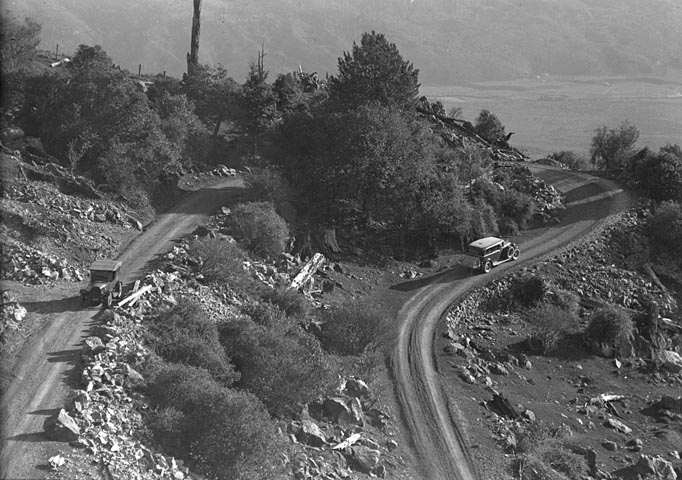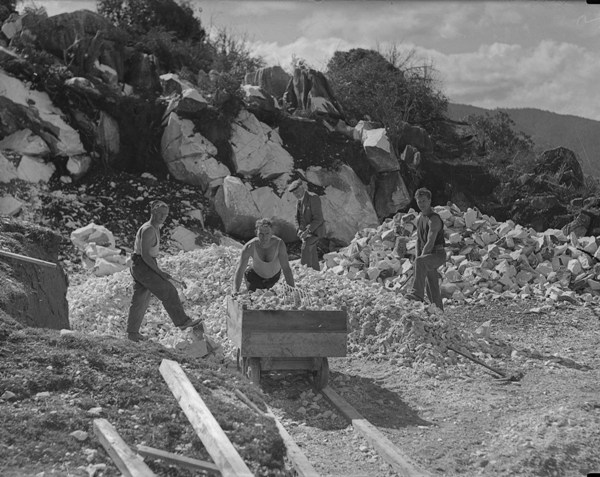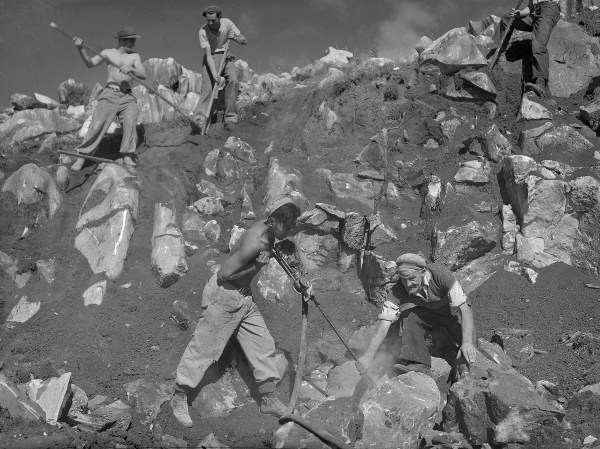The lime and marble of Tākaka Hill
Tākaka Hill divides Nelson and Golden Bay / Mohua. Its steep, twisting road reveals the ancient craggy lime and marble formations and caving system that give the hill its popular name, Marble Mountain.
Tākaka Hill divides Nelson and Golden Bay / Mohua. Its steep, twisting road reveals the ancient craggy lime and marble formations and caving system that give the hill its popular name, Marble Mountain. Its resources have been widely used.
Tākaka Hill is a mysterious place, with its rocky karst landscape and extensive cave system which featured as a film location for Lord of the Rings.
It is also a place of legend. Local Māori believed the taipō (devil) lived in the Canaan area on top of the hill. Taking refuge from Te Rauparaha on the hill at Canaan, they fled when they heard deep underground rumbling, fearing it was the growl of taipo.1 Charles Heaphy who, in 1843 became the first recorded European to cross the hill to Golden Bay / Mohua,2 was later asked whether he had come across the taipō.3 The noises, which can still be heard, are thought to be caused by the underground drainage of the hill4 through the Middle Earth Cave system.
In early years, the usual way to get between Nelson and Golden Bay / Mohua was by sea, around Separation Point. Following the Aorere gold rush in the 1850s, a foot track over the hill was widened and improved. In the 1870s the Bates brothers began calling for a bridle track over the hill to Tākaka, and then a coach road. Planning for a coach road began in 1886, following a different route to that of the foot track. This was despite arguments that a road to Golden Bay should follow the coastline.5 On January 3, 1888, it was announced that two buggies had been driven over the road, taking three and a half hours to ascend the Tākaka side and two hours to descend to Riwaka.6
The opening of a road made the quarrying of the hill's limestone and marble resources possible. Quarrying began at Kairuru,10km from Riwaka7 on the Nelson side of the hill, in the early 1900s.
Marble from there gained national prominence in 1911, when it was chosen for use in the construction of the new Parliament Buildings in Wellington. The Government architect, John Campbell, specified Tākaka marble from Kairuru because it had the necessary strength and could be polished to a high creamy lustre. The heavy marble blocks were transported via a tramline down the steep hillside for 10.4 km to Sandy Bay and shipped to Wellington. A total of 5000 tonnes of marble had been quarried at Kairuru by the time Parliament Buildings were completed in 1922.
Later, the quarry provided marble for the Massey Memorial in Wellington and for decorative features in the Beehive in the 1970s. Some of the old machinery from the original quarry can still be seen on the privately owned Kairuru Farm.8 Today, marble for tiles and building panels comes from a new Kairuru quarry in the Holyoake Valley.9
Limestone from the Tākaka Hill produces high quality lime when crushed.
In 1938 Arthur McKee and his sons Guy and Tasman bought a quarry near Ngarua, which led to the formation of Lime and Marble Ltd. The McKees had established the Fruitgrowers Chemical Company, which produced spraying oils and lime sulphur for the apple industry, Port Māpua in 1932.10 The quarry also supplied lime for glassmaking and burnt lime for local agricultural purposes.11 Lime is still produced from the Ngarua quarry by Ravensdown Fertiliser Co-Op Ltd, near the Ngarua Caves.
2008
Updated February 26, 2025
Story by: Karen Stade
Sources
- Smith, Dawn (1997). Abel Tasman Area History, Department of Conservation, Nelson, NZ., Department of Conservation, p.8.
- Newport, J.N.W. (1978). Footprints Too, Further Glimpses into the History of the Nelson Province, Nelson, N.Z.: Jeff Newport, p.108.
- Heaphy, Charles (1844, January 13). ‘Notes on an expedition from Motueka overland to Massacre Bay' in Nelson Examiner and New Zealand Chronicle, p.385.
- Sixtus, E.J. (1992). Canaan: the hidden land of the marble mountain. Motueka, N.Z., E.J. Sixtus, p.61.
- Newport (1978), p.108-110.
- Newport, J.N.W. (1975) Golden Bay: 100 Years of Local Government, Nelson, NZ., Golden Bay County Council, p.42.
- Newport (1978), p.109.
- Smith, p.21.
- Nathan, Simon and Hayward, Bruce, Building Stone, Te Ara.
- Cleaning up Mapua: The history of the Fruitgrowers' Chemical Company site (2011). Ministry for the Environment.
- Fisher, Helen (2000). ‘Tasman McKee' in The Dictionary of New Zealand Biography, Vol.5, 1941-1960, Auckland, NZ., Auckland University Press and Department of Internal Affairs, p.318. ; McKee, F.R (1943, 10 March),‘Arthur McKee, 1863-1943,' Nelson Evening Mail:
Further Sources
Books
- Blincoe, P. (2001). Yesterdays of Golden Bay: glimpses of past industries and PWD camps. Collingwood, N.Z: Blincoe Publishing. pp 1-18, 21-28.
http://www.worldcat.org/oclc/82251105 - Brodie, Ian (2003, revised ed.). The Lord of the Rings Location Guidebook, Auckland, NZ: HarperCollins, p.62. [Directions to and description of the Canaan location used for Chetwood Forest, which is where Aragorn led the hobbits into the wilds after leaving Bree. Another scene showing the hobbits leaving the shire was also filmed at this location.]
http://www.worldcat.org/oclc/54087891 - Gregory, Kenneth (1976) Land of Streams, Life in the Waimea County Province of Nelson 1876-1976, Nelson: NZ.: Waimea County Council.
http://www.worldcat.org/oclc/3312229 - Henderson, Jim (ed.) (2000). Mountain farm, bush farm. Auckland, N.Z.: Radio Pacific.
http://www.worldcat.org/oclc/154462227 - Martin, J.E. (2004) The House: New Zealand's House of Representatives 1854-2004. Palmerston North, N.Z.: Dunmore Press, p.155, 157.
http://www.worldcat.org/oclc/56324896 - McDonald, J. (2017) How is the river? A Takaka Valley history. Picton: River Press, pp. 171-177.
http://www.worldcat.org/oclc/1016849074 - Millar, J Halket. (1948). Beyond the marble mountain: tales of early Golden Bay, Motueka and Nelson. Nelson, New Zealand: R Lucas & Son Ltd (Nelson Mail). pp.112-118
http://www.worldcat.org/oclc/156262596 - Newport, J.N.W. (1975) Golden Bay: 100 Years of Local Government, Nelson, NZ., Golden Bay County Council.
http://www.worldcat.org/oclc/4809463 - Newport, J.N.W. (1978). Footprints Too, Further Glimpses into the History of the Nelson Province, Nelson, N.Z.: Jeff Newport, p.108.
http://www.worldcat.org/oclc/5829428 - Sixtus, E.J. (1992). Canaan: the hidden land of the marble mountain. Motueka, N.Z.: E.J. Sixtus
http://www.worldcat.org/oclc/154687518 - Smith, Dawn (1997). Abel Tasman Area History, Department of Conservation, Nelson, NZ.: Department of Conservation.
http://www.worldcat.org/oclc/81746678 - Timings, P. (2005) Golden Bay, decades: spreadsheet indexing to research material collected by Pat Timings. Takaka, N.Z. [bibliography of articles etc many held in Golden Bay Museum]
http://www.worldcat.org/oclc/154665451 - Turley, Cliff (2009) Rocks and Hard Places: The Takaka Hill. Dunedin, N.Z.: River Press.
https://search.worldcat.org/en/title/314759148
Newspapers
- Grzelewski, Derek. (1997, Apr/Jun). Tales of the underworld. New Zealand Geographic, 34, 24-52.
https://www.nzgeo.com/stories/tales-of-the-underworld/ - Heaphy, Charles (1844, January 13). ‘Notes on an expedition from Motueka overland to Massacre Bay' in Nelson Examiner and New Zealand Chronicle, p.385.
http://paperspast.natlib.govt.nz/cgi-bin/paperspast?a=d&d=NENZC18440113.2.14 - Lawry, R. Courtney (1989). History of the Lime Industry in the Waimea County, Journal of the Nelson and Marlborough Historical Societies, 2, (3), 5,7,9
http://www.nzetc.org/tm/scholarly/tei-NHSJ05_03-t1-body1-d1.html - Notes taken on a Journey between the Rewaka [sic] and Takaka Districts, 1844. (1844, May 18) Nelson Examiner and New Zealand Chronicle, 3(115), p.43.
https://paperspast.natlib.govt.nz/newspapers/NENZC18440518.2.10
Websites
- Caves in the Nelson area. (n.d.) Nelson Speleological Group.
http://www.nsg.org.nz/mainpages/karst.htm - Cleaning up Mapua: The history of the Fruitgrowers' Chemical Company site (2011). Ministry for the Environment:
https://www.mfe.govt.nz/publications/hazards/cleaning-up-mapua-the-history-of-the-fruitgrowers-chemical-company-site - Department of Conservation. (n.d.) Lord of the Rings locations.
https://www.doc.govt.nz/parks-and-recreation/places-to-go/lord-of-the-rings-locations/ - Fisher, Helen (2000). ‘Tasman McKee' in The Dictionary of New Zealand Biography, Vol.5, 1941-1960, Auckland, NZ., Auckland University Press and Department of Internal Affairs, p.318.
https://teara.govt.nz/en/biographies/5m17/mckee-tasman-joseph - Kairuru Marble. (n.d.) Kairuru Farmstay.
http://www.kairurufarmstay.co.nz/marble.htm - Karst. In Williams, Paul 'Limestone country', Te Ara - the Encyclopedia of New Zealand.
https://teara.govt.nz/en/limestone-country/page-2 - McKee, F.R (1943, 10 March),‘Arthur McKee, 1863-1943,' Nelson Evening Mail. Dictionary of New Zealand Biography.
https://teara.govt.nz/en/biographies/3m15/mckee-arthur - Manatū Taonga — Ministry for Culture and Heritage. (2024). Massey Memorial. NZHistory. https://nzhistory.govt.nz/memorial/massey-memorial
- Nathan, Simon and Hayward, Bruce, (2006). Building Stone, Te Ara - the Encyclopedia of New Zealand.
http://www.teara.govt.nz/en/building-stone/3 - Ngarua Caves.
https://www.ngaruacaves.co.nz/ - Oliver, Steven. (1990). 'Te Rauparaha', Dictionary of New Zealand Biography. Te Ara - the Encyclopedia of New Zealand. https://teara.govt.nz/en/biographies/1t74/te-rauparaha
- Walrond, C. (2010) Tunneling to Takaka, in: Nelson region - Geology and landforms, Te Ara - the Encyclopedia of New Zealand.
http://www.TeAra.govt.nz/en/nelson-region/2
Maps
Materials held at the Nelson Provincial Museum:
- Campbell, Alexander Le Grand. (1848; 1852) Diary [exploration trip of Takaka Hill]. MS CAM.
- Johnstone, Paul. (2006). No stone left unturned: a history of the mineral extraction industries of the Nelson Province. qMS JOH.
- Lawry, Courtney. (10.10.2005). Takaka Hill marble. Sound recording. NHS 137.
- Sixtus family. (1928-2003). Canaan Downs collection. AG 494.
 Tākaka Hill Road, The Nelson Provincial Museum, Ellis Dudgeon Collection, 212128/7
Tākaka Hill Road, The Nelson Provincial Museum, Ellis Dudgeon Collection, 212128/7 Takaka Lime Works Nelson Provincial Museum, Kingsford Collection, 163231/6
Takaka Lime Works Nelson Provincial Museum, Kingsford Collection, 163231/6 McKee Lime and Marble Co Tākaka, The Nelson Provincial Museum, Kingsford Collection 165163
McKee Lime and Marble Co Tākaka, The Nelson Provincial Museum, Kingsford Collection 165163